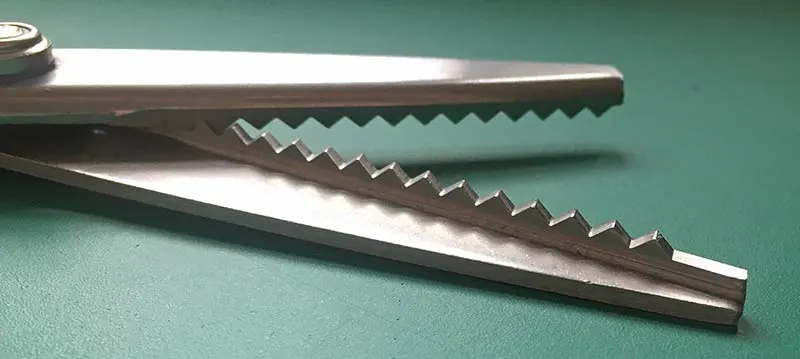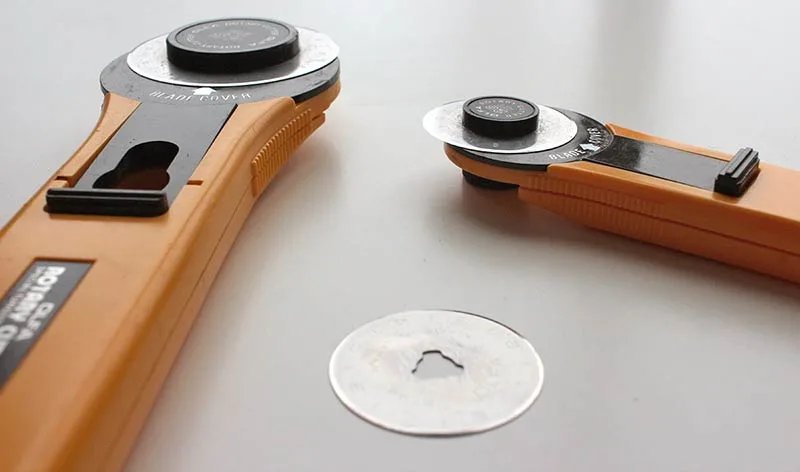If you’re new to sewing and have made a visit to any well-stocked haberdashery, you may be wondering what the essential cutting tools for sewing are or even the most appropriate cutting tool used when it comes to cutting fabrics!
There are, afterall, so many tools that you can use to cut out fabric and paper patterns, that it can feel mind-blowing knowing which scissors might be best – or even if you should be using scissors!
Well, this post is for you, sewing beginner!
Today I am going to cover some of the most frequently asked questions about fabric cutting and paper cutting tools, and will also provide some lovely close-up photos to help guide you when you next buy some tools!
Some of the links in this article are affiliate links. This means that I may receive a fee at no extra cost to you if you purchase a recommended product.

Cutting Tools Questions
Let’s take a look at some of the frequently asked questions that I get asked about sewing cutting tools!
What Cutting Tools Are Used By Home Sewists And Dressmakers?

Most home sewists and dressmakers have a selection of cutting tools.
They could have several pairs of shears and scissors, each with a different purpose, as well as a selection of blades for cutting – these could be either straight or rotary cutters!
What Are The Best Sewing Scissors?
The best sewing scissors for sewing are shears. This is because the upper blade is cut slightly differently, allowing for a cleaner cut through several layers of fabric.
Shears also have the handles at an angle, making it easier to cut long pieces of fabric in one cut.
The best sewing scissors will have long blades to make the most of cutting fabric in one long cut. The shorter the blades on your fabric scissors, the more cuts you need to make, which leaves room for error.
This is really the only difference between fabric scissors and regular scissors.
Read my article comparing shears vs scissors for more information!
What Are Fabric Scissors Used For?

Fabric scissors are used for cutting all woven and knitted fabrics, non-adhesive interfacings, and tailoring items such as horsehair and wadding.
They are also used for cutting leather and suede but if you do plan to cut these materials, be sure to invest in a pair of heavy duty fabrics that can handle them.
I would even keep a separate pair of fabric scissors for leather, suede and non-woven materials, to minimise the chance of blunting them!
So, what are the different cutting tools for sewing?
Sewing Cutting Tools And How They Work

- Fabric shears
- Angled fabric scissors
- Paper scissors
- Pinking shears
- Rotary cutters
- Small sharp scissors
- Duckbill scissors
- Thread snips
- Button hole cutters
- Seam ripper
- Craft knife
Let’s dig a little deeper into each of the functions of these sewing cutting tools!
Fabric Shears
These are my favourite cutting tool when sewing.
Shears have longer blades than scissors – 7 inches or more are classified as shears! – which helps to make long clean-cut lines in your fabric.
Shears also have handles that differ from scissors – a smaller hole for your thumb, with a bigger space for your fingers. This helps provide more control when cutting fabric.
1. Best Left Handed Shears
2. Best 8″ Shears
3. Best 9″ Shears
Professional 9″ Tailors Shears
- Heavy duty shears
- Designed for dressmaking and tailoring
VIEW ON AMAZON
Angled Fabric Scissors
These are much like shears, except that they have the handle at an angle to the blade.
This can make it easier to cut accurately, as the lower blade lays upon the worktable and the hand can cut comfortably.
Paper Scissors
I have included paper scissors because sewing will require cutting paper as well as fabric, and your fabric scissors or shears should never be used for paper.
It will blunt them, and you will ruin your fabric when you next try to cut with them.
These are a great 8″ pair of paper scissors that work well!

Pinking Shears
Pinking shears are similar to regular scissors but the blades look like the teeth you see on a saw.
When these teeth cross over the fabric, a zig-zag effect happens to the fabric, which makes the fraying process on woven fabrics a little slower.
Pinking shears can also be used to grade seam allowances down, though I personally prefer to use fabric scissors and have a straight edge.
You can read my article to learn more about how pinking shears work.

Rotary Cutters
Rotary cutters are cutting tools that have a circular blade attached to a handle.
To cut fabric with a rotary cutter, the circular blade is rolled along the surface of the fabric and with pressure applied, cuts through.

Rotary cutters should always be used with a cutting mat to protect your work table, and you should always roll the blade away from you for safety.
Learn more about self healing cutting mats here – including the one I use and love!
I use a large rotary cutter for straight cutting lines or gentle curves, and a small rotary cutter blade for tighter curves and corners.

Small Sharp Scissors
I have quite a few short sharp scissors to hand.
I don’t like thread snips and find these perfect for cutting my threads when I’ve finished machine sewing, or even just trimming seam allowances down on French seams and flat-felled seams.
They’re also great when used to cut paper fabric or thread ends!

You do not need to spend much on these small sharp scissors, and if the blade is under 6 cm you may be able to take them on flights as part of your sewing kit.
Duckbill Scissors

I discovered these via Instagram.
Duckbill scissors are used for embroidery and applique. They have what looks like a ‘duck’s bill’ which works to protect the embroidery or applique project from accidental cutting.
With duckbill scissors, you can cut close to an appliquéd seam to trim away the excess fabric and not have a panic attack during the process!

Thread Snips
Thread snips are a sewing cutting tool that I have never been able to get on with. I have tried over the years, but they just don’t ‘do it’ for me.
Used to cut threads when sewing, or clipping seam allowances, thread snips are often worn around the neck on a lanyard.
Buttonhole Cutter
A buttonhole cutter is much like a woodwork chisel.
You use the buttonhole cutter by placing the sharp end over the button-hole stitches and applying pressure so that the buttonhole is cut open.
Or you could grab a hammer wood-working style, but that may be a little too much force!
This buttonhole cutter is great. I’ve had several small accidents when cutting open my button-holes, and this tool makes that a less likely occurrence!
Seam Ripper

My seam ripper goes everywhere with me! I use mine to rip out seams that aren’t ‘perfect’ but also to deconstruct sewn items.
I learn more from seeing, so using a seam ripper to deconstruct clothing and accessories has helped me constantly improve with my garment construction skills.
This seam ripper is a great size and super comfortable to use.
Craft Blade
I don’t have a craft blade, I have a surgeon’s scalpel! I shan’t go into the why, but it is much like a craft blade.
Super sharp, and allows for precision cutting. I have quite a few blades (again, don’t ask) and am able to use the scalpel for both fabric and paper cutting.
This great X-acto knife allows for precision cutting!
Extra Cutting Tools For Sewing
Not actually sewing cutting tools, but these are considered important when cutting fabric!
- Cutting mat – I prefer the self-healing variety and have a variety of sizes
- Awl – I use this for marking key points on patterns and some non-grain materials
- Hole punch – this is used when putting eyelets in fabric or working with second-hand leather
- Pattern weights – to weigh down your sewing patterns to aid more accurate cutting
Cutting Tools Specific To Material
The first consideration when it comes to buying any cutting tools for sewing is to think about the cutting tool’s end use.
By that I mean, what ‘material’ will the cutting tools be cutting?
Cutting Tools For Sewing Paper

When sewing, you will at some point need to cut paper.
This could be cutting out the PDF sewing pattern that you have printed and stuck together or modifying a paper pattern, tracing it off and cutting out the new version.
Papercutting tools are an important tool in your sewing kit.
You could use a regular pair of scissors, a special shorter blade scissor for patterns, or even a rotary cutter whose sole use is for cutting paper.

I use these shorter blade pattern scissors from Morplan and this small-sized rotary cutter for my paper cutting needs; all are fab for cutting my paper accurately and stay sharp for some time too.
Cutting Tools For Sewing Fabric

Whether you’re new to sewing, or a dab hand with years of experience, you will no doubt have heard that your fabric blades should never go near paper.
The reason for this is that paper blunts the blades, and there is nothing more painful or distressing than cutting fabric with blunted scissors.
I keep several pairs of fabric shears and rotary cutters on hand for different uses, making sure that there is no crossover of materials so that they each have a longer life.

When cutting fabric, I like to use either very long blades like these shears or a large rotary cutter – bigger than the one I use for paper.
Some people also like to use these pinking shears for neatening up seam edges, but I only use them when home visiting my Ma.
Cutting Tools For Sewing Leather

Leather is ‘tougher’ than either knitted or woven fabric and so I always use a separate cutting tool when working with leather.
Having spent many, many hours cutting leather out in previous places of work, I have given up on using scissors and almost exclusively use surgical blades that a kindly hospital worker gave me years ago when I was a university student.
That box of several hundred has lasted well, but when the blades are not near me, I reach for my small rotary cutter, again used only for leather.

Cutting Techniques
Now, something else you may not know is there is no real ‘correct’ way to use scissors. Seriously.
Using Scissors To Cut Fabric
People will try to tell you that scissors should be held like this, or used like that, but the reality is that different scissors have been designed for left-handed peeps and right-handed peeps, and the real ‘choice’ is which side of the pattern you like to cut.
When cutting out fabric with my fabric shears, I will sometimes cut with the edge of the pattern to the left of my blades, and at other times it is to the right.
If you have pinned the pattern pieces correctly or weighted them down with pattern weights, you will have room to manoeuvre your scissors blades and all will work out.

Just cut slow and steady, and try to use as much of the length of the blade as possible rather than short snips which can leave a more ragged edge prone to fraying.
What you should NEVER do, however, is lift the fabric and pattern from the worktop with your opposite hand, as this will ‘shift’ the fabric and potentially leave you with more or less fabric on that edge.
Using Scissors To Cut Paper
Interestingly, I change this for cutting paper. I can actually only cut paper accurately when I cut paper with the blade to the right of the line I need to cut.
Perhaps it gives me more control or maybe my eyes are more able to focus this way?
Either way – and I am a righty – I never cut with my scissor blade to the left of the cutting line. It just feels beyond weird!
Using A Rotary Cutter To Cut Fabric And Paper
Another favourite when cutting out fabric is to use a rotary cutter << this is the one I love and use!
These are circular blades held in place and you hold the ‘handle’ which is the length of plastic. Often it is contoured to your hand so that you have more control over where the blade cuts.

When using a rotary cutter, I like to work with the blade moving away from my body and angled slightly away from the pattern so that if my hand does slip, I don’t end up bleeding on my fabric – that would be rotten luck!
Using A Blade To Cut Leather And Other Materials

Finally, when it comes to cutting leather or other materials such as PVC, vinyl, and suede, I use my trusty surgical blade. This requires a lot of care. It’s called ‘surgical’ for a reason!
I typically use a metal ruler / french curve to ‘block’ the blade while cutting around the pattern pieces.

I’ll also point out that when working with a surgical blade and these materials, I ALWAYS trace the pattern pieces onto card.
Card is thicker, more durable, and will put up a little bit more of a fight to protect my fingers than paper will.
Cutting Leather Safely
I have to cut towards me due to how the blade is created, so I always ALWAYS cut with my body to the left of the pattern and blade.
This way, if I do slip and go off towards my body, I am less likely to catch my body with the blade.
If you don’t have access to surgical blades, I have used these craft blades previously when working with leather and other materials. They’ve worked well for me in the past, giving a nice sharp clean line.
I do suggest buying more blades than you think you’ll need as they do go blunt quite quickly with non-grain materials.
Sewing Cutting Tools Conclusion
The choice of the most appropriate cutting tool used when cutting fabrics or paper is really down to personal preference – some people prefer fabrics scissors, others fabric shears and still others will only ever use a rotary cutter when cutting out their sewing fabrics. It really is a personal choice!
If you feel like I missed something, or you have questions I haven’t covered, do let me know in the comments below!




sameena
Tuesday 21st of September 2021
Please can i use photographs in your website for the academic purposes in class room teaching. I am thankful if you give me permission. Thank you.
Eve Tokens
Sunday 26th of September 2021
Hi Sameena! Yes, you may use the photos in this post for educational purposes in the classroom only. Thank you for respecting my copyright and seeking permission first. Best, Eve
Salvy Tarrega
Friday 1st of May 2020
You are awesome! I love all your content! Thank you for sharing this precious knowledge with us newbies :)
Eve Tokens
Tuesday 12th of May 2020
Oh Salvy! Such a lovely comment to see! Thank you - I love sharing knowledge and helping others! Have a fab day! :)
Susan
Thursday 1st of August 2019
Thanks sooo much for all the good advise on sewing patterns. I am a newbie to dress making and my first pattern arrived today, as I want to make a summer dress for my grand daughter. Your instructions as helped me understand the pattern much more clearly, although I have lot to learn.
Many Thanks
Wednesday Weekly #182 – Helen's Closet
Wednesday 24th of July 2019
[…] Creative Curator shared this really in-depth article all about cutting tools for sewing. I definitely learned something new reading this […]